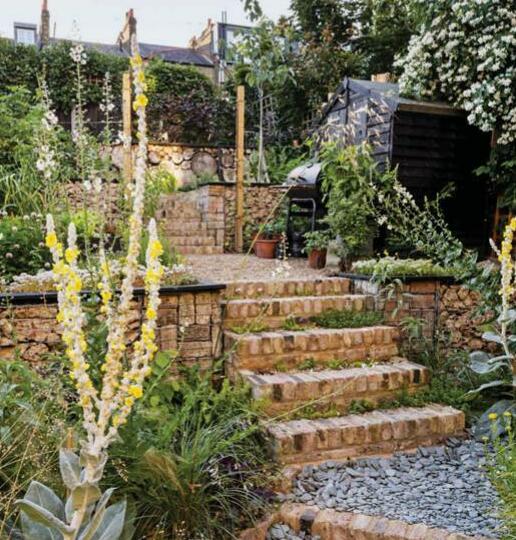يحاول ذهب - حر
Thrifty garden style
May 2023
|BBC Gardeners World
In the latest of our budget-savvy series, Tom Massey shares design tips that needn't cost the earth

With creative thinking, clever use of materials and sourcing of plants, you can add design elements to your garden that won't break the bank. Some items, such as belowground drainage and structural work, are probably best left to expert landscapers, but there are plenty of ideas that you can try out yourself. These design tips are intended to be cost effective, but also good for the environment and great for supporting local wildlife.
Cost-effective garden updates
Three ways to stretch your budget, while helping the environment

Hard landscaping
Hard landscaping is a key feature of any garden design as it forms the bones of the garden and is generally the most expensive element. However, there are still many ways to make it thrifty.
Think about what you're removing - can you re-use old slabs? A crusher can be hired on a day rate and used on unwanted hard materials to lay as sub-base (essential for a stable installation) or even to use as decorative stone chippings. This is cheaper than buying freshly dug aggregates and more sustainable, too.
If buying new paving, particularly if it's very cheap, do check it has been ethically sourced. You can also search online marketplaces or reclamation yards for reclaimed stone. Then think about how you could enhance the materials - concrete slabs can be polished to create a terrazzo-like effect, or you could cut larger pavers and lay in a herringbone pattern for added interest. Also consider leaving gravel channels or planting pockets between slabs this reduces the cost and aids drainage.
هذه القصة من طبعة May 2023 من BBC Gardeners World.
اشترك في Magzter GOLD للوصول إلى آلاف القصص المتميزة المنسقة، وأكثر من 9000 مجلة وصحيفة.
هل أنت مشترك بالفعل؟ تسجيل الدخول
المزيد من القصص من BBC Gardeners World

BBC Gardeners World
Winter wildlife watching
Love watching wildlife in your garden? Even in winter there are plenty of ways to observe and appreciate birds, insects, pond life and even some small mammals if you're lucky.
4 mins
December 2025

BBC Gardeners World
Garden globetrotting: The Dolomites
For a mountain holiday with a difference, Catherine Mansley found that South Tyrol offers something for all the family to enjoy, including gardens and plants galore
2 mins
December 2025

BBC Gardeners World
The Full Monty
Changes are afoot in the hazel coppice at Longmeadow - Monty reveals the reasons behind this bold step and outlines his new vision for this area
3 mins
December 2025

BBC Gardeners World
Expert's choice Variegated hollies
When it comes to sex, holly names are confusing, but get it right and you'll get berries galore,
1 mins
December 2025

BBC Gardeners World
We love December
I have been trying to compose a hit Christmas single based loosely around gardens and gardening.
5 mins
December 2025

BBC Gardeners World
Get set for CHANGE
Winter is the perfect time to plan changes in your garden - Alan Titchmarsh looks at how to work out what to do and when, as he prepares for big changes himself
6 mins
December 2025

BBC Gardeners World
Root of the matter
Why winter is the best time to design your garden, including assessing and adding structure during peak planting time and finding the beauty in decay
3 mins
December 2025

BBC Gardeners World
Christmas at Longmeadow
With the festive season upon us, Monty shares his plans for Christmas at Longmeadow - read on for sprouts, mistletoe, Christmas trees and more.
4 mins
December 2025

BBC Gardeners World
Winter wanders
There's plenty to see in many of our 2 for 1 Gardens this month - here are just a few highlights to tempt you outside for an inspiring walk amid winter's crisp beauty
2 mins
December 2025

BBC Gardeners World
Starting over
In the final part of his series, Nick Bailey shows you how plants can bring a new garden design together
3 mins
December 2025
Translate
Change font size

